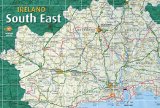South East Ireland Tourism
Travel guide to Ireland's south east
Travel guide to Ireland's south east
Duncannon, Wexford
According to legend, Duncannon dates back to the time of Fionn Mac Cool and the Fianna in the 3rd century. Duncannon was of strategic importance on the vital sea penetration of Waterford Harbour. It was greatly involved in wars and sieges for almost 17 centuries. Leaders and kings have landed on and fled its portals, armies have struggled, and Napoleon sought and got intelligence from its strength and weakness. James II, and later his son in law William of Orange, marched on its cobblestones. It is still used as a modest Irish army post, mainly for summer training. It has a sandy beach with fishing and pleasing amenities, which makes it a very popular resort.
This popular fishing village boasts a star shaped fortress, Duncannon Fort, which was built in 1588. The Fort which incorporates a maritime museum, cockleshells arts centre, café and craft shop is open to visitors from June to September daily .
Blue flag status was also awarded to Duncannon Beach which is where the International Sand Sculpting Festival takes place every year.
Feeling hungry? Facing Duncannon Fort, is the Strand Tavern with its unique bar counter and even some seating from Croke Park Stadium (Ireland's most important sporting and cultural venue).
Cinema Buffs might be interested to know that Duncannon Village and Fort was the recent location for the epic remake of the 'Count of Monte Cristo'.
<< Return to Wexford page
Things To Do in Duncannon
Duncannon is one of the villages in South West Wexford, featured on the clearly signposted and very scenic circuit (Ring of Hook Drive) which visits Fethard-on-Sea, Slade and Hook Head.This popular fishing village boasts a star shaped fortress, Duncannon Fort, which was built in 1588. The Fort which incorporates a maritime museum, cockleshells arts centre, café and craft shop is open to visitors from June to September daily .
Blue flag status was also awarded to Duncannon Beach which is where the International Sand Sculpting Festival takes place every year.
Feeling hungry? Facing Duncannon Fort, is the Strand Tavern with its unique bar counter and even some seating from Croke Park Stadium (Ireland's most important sporting and cultural venue).
Cinema Buffs might be interested to know that Duncannon Village and Fort was the recent location for the epic remake of the 'Count of Monte Cristo'.
Duncannon Map
<< Return to Wexford page






